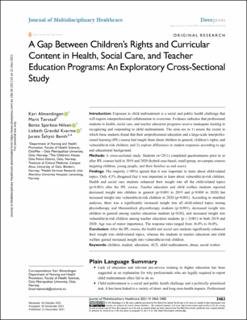| dc.contributor.author | Almendingen, Kari | |
| dc.contributor.author | Tørstad, Marit | |
| dc.contributor.author | Sparboe-Nilsen, Bente | |
| dc.contributor.author | Kvarme, Lisbeth Gravdal | |
| dc.contributor.author | Saltyte Benth, Jurate | |
| dc.date.accessioned | 2022-03-22T10:05:47Z | |
| dc.date.available | 2022-03-22T10:05:47Z | |
| dc.date.created | 2021-12-01T08:31:08Z | |
| dc.date.issued | 2021-11-25 | |
| dc.identifier.issn | 1178-2390 | |
| dc.identifier.uri | https://hdl.handle.net/11250/2986738 | |
| dc.description.abstract | Introduction: Exposure to child maltreatment is a social and public health challenge that will require interprofessional collaboration to overcome. Evidence indicates that professional students in health, social care, and teacher education programs receive inadequate training in recognizing and responding to child maltreatment. The aims are to 1) assess the extent to which these students found that their uniprofessional education and a large-scale interprofessional learning (IPL) course had taught them about children in general, children’s rights, and vulnerable/at-risk children; and 2) explore differences in student responses according to age and educational background.
Methods: A cross-sectional study. Students (n=2811) completed questionnaires prior to or after IPL courses held in 2019 and 2020 (hybrid case-based, small-group, on-campus courses targeting children, young people, and their families as end users).
Findings: The majority (>90%) agreed that it was important to learn about child-related topics. Only 4.3% disagreed that it was important to learn about vulnerable/at-risk children. Health and social care students enhanced their insight into all the child-related topics (p<0.001) after the IPL course. Teacher education and child welfare students reported decreased insight into children in general (p<0.001 in 2019 and p=0.008 in 2020) but increased insight into vulnerable/at-risk children in 2020 (p=0.001). According to stratified analyses, there was a significantly increased insight into all child-related topics among physiotherapy and Mensendieck physiotherapy students (p<0.001), decreased insight into children in general among teacher education students (p<0.02), and increased insight into vulnerable/at-risk children among teacher education students (p ≤ 0.001) in both 2019 and 2020. Age was of minor importance. The response rates ranged from 16.0% to 36.0%.
Conclusion: After the IPL course, the health and social care students significantly enhanced their insight into child-related topics, whereas the students in teacher education and child welfare gained increased insight into vulnerable/at-risk children. | en_US |
| dc.language.iso | eng | en_US |
| dc.publisher | Dove Press | en_US |
| dc.relation.ispartofseries | Journal of Multidisciplinary Healthcare;Volume 14, 2021 | |
| dc.rights | Navngivelse-Ikkekommersiell 4.0 Internasjonal | * |
| dc.rights.uri | http://creativecommons.org/licenses/by-nc/4.0/deed.no | * |
| dc.subject | Children | en_US |
| dc.subject | Students | en_US |
| dc.subject | Education | en_US |
| dc.subject | Adverse childhood experiences | en_US |
| dc.subject | Child maltreatment | en_US |
| dc.subject | Abuse | en_US |
| dc.title | A gap between children’s rights and curricular content in health, social care, and teacher education programs: An exploratory cross-sectional study | en_US |
| dc.type | Peer reviewed | en_US |
| dc.type | Journal article | en_US |
| dc.description.version | publishedVersion | en_US |
| dc.rights.holder | © 2021 Almendingen et al. | en_US |
| cristin.ispublished | false | |
| cristin.fulltext | original | |
| cristin.qualitycode | 1 | |
| dc.identifier.doi | https://doi.org/10.2147/JMDH.S344729 | |
| dc.identifier.cristin | 1962346 | |
| dc.source.journal | Journal of Multidisciplinary Healthcare | en_US |
| dc.source.volume | 14 | en_US |
| dc.source.issue | 14 | en_US |
| dc.source.pagenumber | 3463—3483 | en_US |

